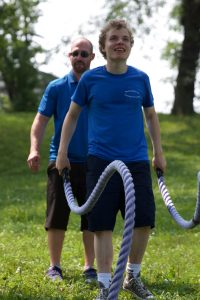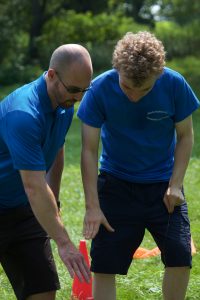Seriously, what aren’t the benefits of fitness for the autism population? As human beings, we all need to move for optimal health and development. Last I checked (approximately four minutes ago), individuals with autism and related disorders were, in fact, human beings. When discussing the inherent benefits of exercise, certainly there are physical, behavioral, and cognitive areas of ability that can receive a boost in quality.
When discussing fitness for the the autism population it is important to understand what we need to address and how best to assess abilities, develop a program that meets current needs, and strategies for progress. With my Autism Fitness programming abilities and goals are focused on three categories; Physical, Adaptive, and Cognitive. In this article I want to discuss the importance of each of these abilities and some exercise guidelines.
 Global Physical Strength and Stability
Global Physical Strength and Stability
Strength is an area of physical ability that is often a deficit for those on the autism spectrum. The foundation for all other movement, strength is a factor in everything we do, every task we perform on a daily basis. There is a significant segment of the ASD population with less-than-adequate strength levels for performing daily life and other tasks safely and effectively.
In addition to being a proactive skill, strength is a safety skill. The stronger we are in the basic movement patterns (pushing, pulling, squatting, locomotion), the less likelihood for injury over time. Low back pain is a very common issue in our society, and one related directly to strength. While the lumbar region may be the area of discomfort, tightness and weakness of the hips is the most significant contributor to the problem.
Consider a non-verbal teen with autism who sits a lot all day. There is a good chance that low back discomfort can become an issue. That individual may have difficulty communicating his/her discomfort. Well-designed and consistent fitness programs that incorporate progressive strength exercises can serve as a preventative measure here.
Over a lifetime, some of us may engage in a variety of different physical activities from team sports to martial arts to swimming to other individual pursuits. Underlying all sport- or activity-specific movements are baseline strength, stability, and motor planning skills.
Developing the general components of physical fitness makes sense for both those who do engage in other athletic activities and for those who do not. Exercises that are general in form (pushing, pulling, squatting, locomotion) can enhance physical functioning in other areas of life and activity. Sport-specific movements are finite, and tend not to generalize or crossover to other situations.
Even as interest in and opportunities to engage in sports activities may fade, fitness activities that focus on strength, stability, and motor planning can always be implemented and progressed over a lifetime.
Adaptive/Emotional Well-Being
It is common for individuals with autism to have limited interests and preferred activities. Preferred activities are typically sedentary and/or perseverative (the same movement or physical stereotypy repeatedly). Providing new movement opportunities that are also reinforcing/fun creates an entirely new class of options for this population.
I’ve introduced medicine ball throws, jumps, and fitness rope swings to my athletes who, months later, are independently seeking out these experiences. This is usually not an overnight process, but one that requires consistency, positive reinforcement (behavior-specific praise), and progression. The planning is completely worthwhile when an athlete discovers that he or she enjoys a particular exercise.
A good amount of research and anecdotal evidence support the statement that exercise can have positive effects on mood and behavior in the neurotypical population. While it is not a replacement for behavioral interventions and an appropriate, individual-centered environment, exercise programs can yield some of these same benefits for those with autism.
Because new tasks, particularly physical activities, can be initially non-preferred or anxiety-provoking for individuals with ASD, it is important that programs are introduced at current ability level (progressed or regressed as needed), consistently, and in an appropriate, supportive environment. Fitness time should be the one point during the day where an individual can expect to succeed in some way.
That Elusive Characteristic: Independence.
Independence can have different meanings depending on each individual. For some, the ability to perform basic life skills (washing, hygiene, taking out the garbage or carrying laundry) is an achievement. For others, transitions into less structured home or educational environments can be considered pivotal life points.
Fitness programs, as discussed from the physical and adaptive sections, can provide some of the important skills necessary to navigate the world successfully. Strength and stability gained from appropriate and progressive fitness programming can lead to less reliance on others for certain tasks. Additionally, fitness can be an outstanding small group activity, even among those with varying levels of ability. Because general fitness programs can be adapted to any individual, group-based exercise does not have to be exclusive.
Independent or less restricted living environments are going to be a major topic within the autism community within a few years. Fitness is essential to the physical, social, and general/health wellbeing of those with ASD. Programs that focus on long-term implementation can provide sustainable progress over the life of any person. Modeling these programs around physical, adaptive, and cognitive skills is crucial to meeting the needs of the population.
The concept of autonomy is huge in fitness program. When an athlete demonstrates a preference for an activity or wants to do the offered choices in a specific order, we go with it. Independence starts here, with selections based on a few possibilities. This is also the groundwork for creative active play.
Cognitive and Long-Term Health
With respect to fitness, cognitive functioning focuses on learning style, and determining whether an individual learns a specific exercise better with a visual or physically prompted cue. This enables optimal coaching and quicker skill acquisition.
It seems that regular physical activity leads to enhanced cognitive functioning in neurotypical populations, though it may be difficult to assess enhancement in the ASD population. There are, however, great opportunities in fitness programming for the addition of speech and educational targets, specifically those dealing with short-term memory, prepositions (in, on, under, left/right), and verbs. Some of my favorite progressions involve teaching athletes to differentiate between similar-sounding cues. In Autism Fitness programming we use three basic medicine ball throws; push, scoop, and overhead. Once an athlete is able to perform each of these independently, we can progress to switching between the throws. An athlete who is able to successfully discriminate between the cue “Do an overhead throw” and “Do a scoop throw” has certainly demonstrated an increased working vocabulary (even if they are non-verbal) and the ability to follow a direction with multiple similar options.
 The Important Stuff in Short
The Important Stuff in Short
Fitness can be described as the “missing key” to optimal life development for the autism and special needs populations, however as professionals, caregivers, and parents, we can begin to change the current climate. Sports-based programs are not the only option and general fitness programs lend more towards developing essential physical skills and creativity. Appropriate fitness programs for individuals and groups should:
- Focus on the foundations of physical ability, strength, stability, and motor planning
- Include the Big Movement Patterns: Pushing, Pulling, Squatting, and Locomotion
- Feature activities that can be progressed or regressed based on physical ability
- Take into account and program for adaptive and cognitive functioning
- Provide safe, supportive environments
- Include other speech, educational, or social goals where appropriate
- Consider both short- and long-term physical health
- Allow for autonomy in activity selection
Fitness Programming
Rather than an approach that attempt to introduce a hundred different exercises, I have about 8-10 go-to exercises that can be progressed (made more challenging) or regressed (made simpler) based on the physical, adaptive, and cognitive abilities of the individual. Using the “Big Movement Patterns” mentioned earlier, activities including low hurdle steps, medicine ball throws, body weight squats, crawling patterns, Sandbell/sandbag presses and carries, and resistance band pulls are all outstanding foundational exercises for any fitness or Adaptive PE program. If you are not familiar with these exercises or equipment there are many videos on the Autism Fitness YouTube channel: YouTube.com/TheAutismFitness
Fitness and regular physical activity is absolutely crucial for the current and long-term health and optimal development of those with autism. While developing and integrating a program may seem overwhelming, using the key concepts and activities mentioned here can provide a great template for an effective outcome. Start with short durations of programming (5-10 minutes) and as motivation increases, you and your athlete(s) will have greater opportunity to succeed.
Eric Chessen, M.S., is the Founder of Autism Fitness. An Exercise Physiologist with an extensive background in Applied Behavior Analysis, Eric provides on-site and distance consulting worldwide. He is the creator of the Autism Fitness Toolbox available at AutismFitnessToolbox.com

